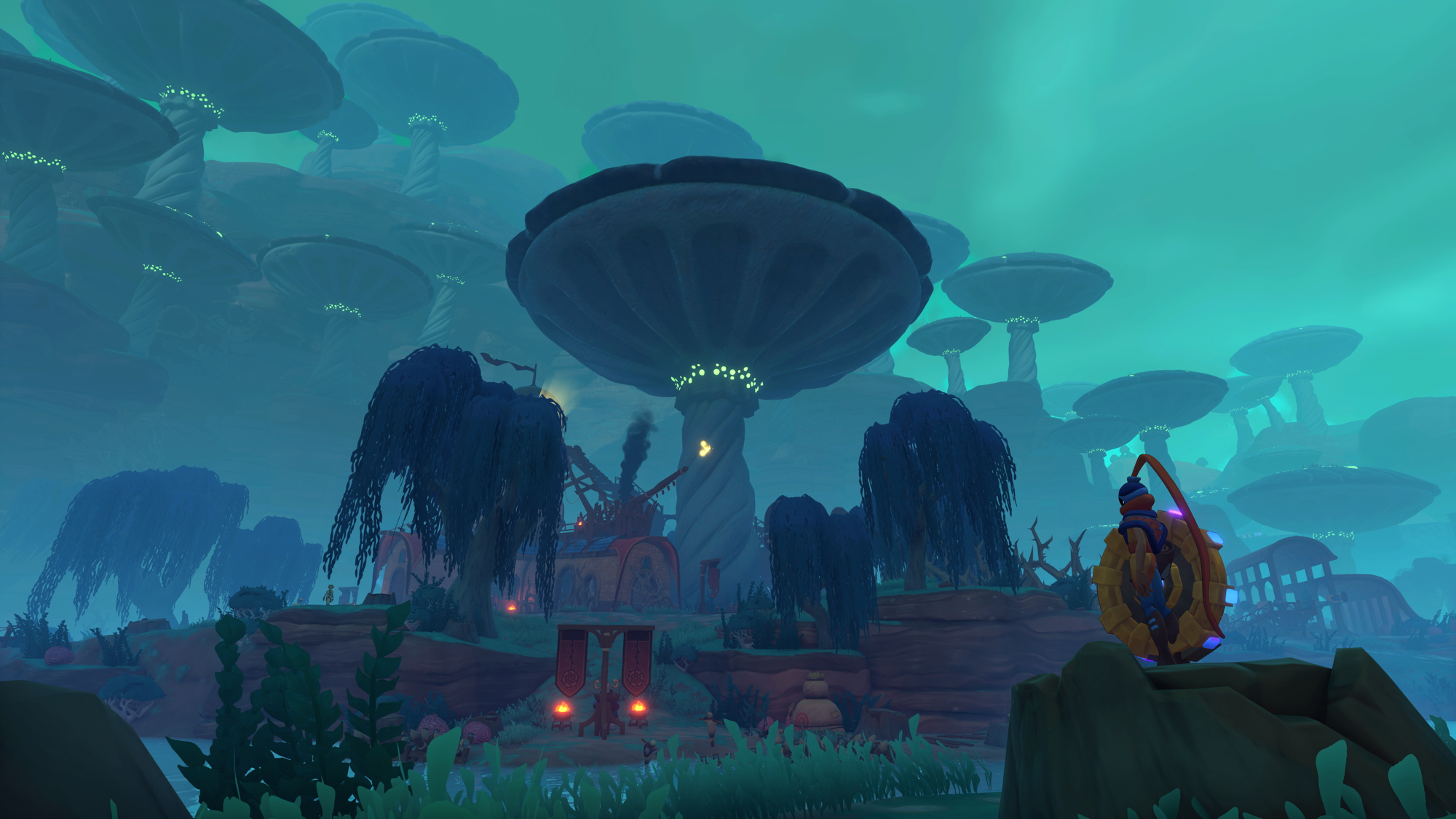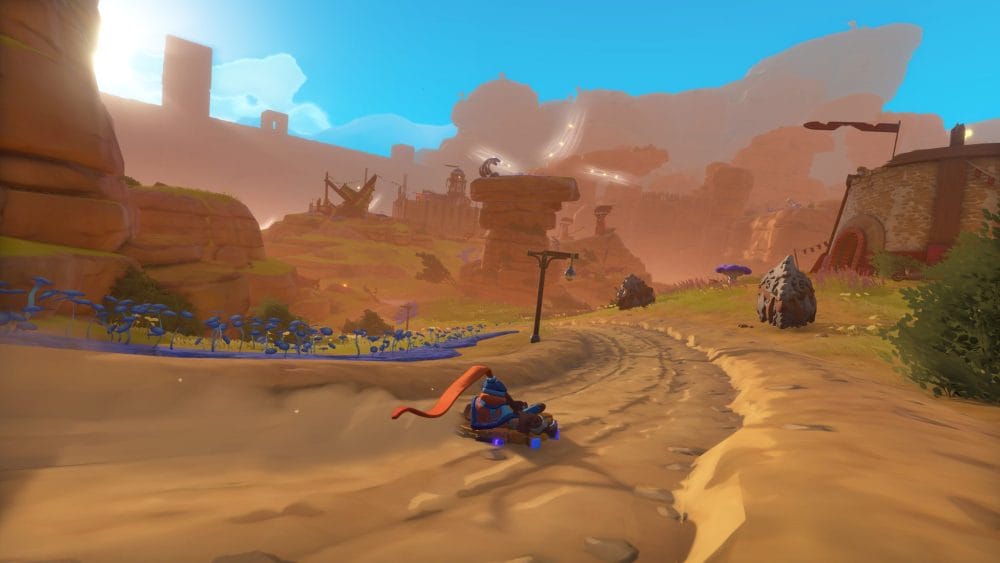While many indies that take inspiration from Nintendo’s beloved The Legend of Zelda series often recreate the scope and game design of the original 2D entries, Twirlbound’s The Knightling is part of a newer slew of indie titles taking inspiration from Nintendo’s more recent 3D outings, such as The Legend of Zelda: Breath of the Wild. While this would be an impressive feat in its own right, the studio has also tried blending it with PlayStation 2 and GameCube era 3D platforming game design and action elements. It’s an admirable goal for a small studio, but unfortunately the results are mixed.

Story
The Knightling follows a titular “Knightling”, an apprentice to a gallant knight known as Sir Lionstone, who becomes separated from their mentor while out on a quest. Upon their separation, the Knightling becomes responsible for Lionstone’s legendary shield, which they must used to find their missing mentor and overcome a growing evil threatening the land of Clessia.
The game doesn’t hold itself to any narrative grandeur, which is to its benefit as it maintains a light-hearted tone similar to the aforementioned PS2-era 3D platformer influences. While none of the characters are all that memorable or even identifiable given their fairly similar character designs, the narrative maintains a level of charm thanks to its storybook nature, and some entertaining writing.
Outside of one or two cutscenes, there’s no voice acting in The Knightling outside of the protagonist’s shield, which later becomes a voiced companion known as Magnustego, who randomly interjects during gameplay with quips to make traversal feel less isolating. The issue with this character is that his role in the narrative never feels necessary, nor does he have any kind of relationship or bond with the main character. He is along for the journey purely to speak for the player at random points, which is made even stranger by the fact that the Knightling themself is not a silent protagonist. Furthermore, Magnustego has a very Jeremy Irons-like voice performance, and while it is fitting to the game’s setting and tone, the performance itself feels a little too dry and lacking in direction at times.

Gameplay
On Xbox Series X, The Knightling runs at 30 frames-per-second, somewhat surprisingly given the game’s stylized cartoony graphics and somewhat rough visual features such as pop-in when traversing the open world. The biggest problem with this, one that drags down the entire experience, is an instantly identifiable amount of input lag that acts as an antithesis to every positive I can levy at The Knightling’s gameplay. The game is a 3D action platformer with brutally unresponsive controls that never allows the combat or platforming to feel anything other than frustrating and unresponsive.
With this in mind, it’s difficult for me to praise The Knightling’s open-world and traversal mechanics, but the reality is that I did quite like what is on display here. The game features what I can imagine is a very satisfying movement system where the player can slide on Magnustego to traverse the map, with pieces of moss growing from the ground granting them a boost for launching off ramps – at least, that is, when you aren’t wrestling with the controls. There were pockets where I enjoyed sliding around the world, or gliding through the air, but they were almost always brought to an abrupt stop by my reaction time being interfered with due to input latency issues.
The worst example of this by far is with the game’s combat. The Knightling uses the protagonist’s primary weapon as a shield to prioritize defensive and offensive combat. This means, of course, combat is heavily dependent on blocking and, as we’ve all come to expect in recent years, parrying. The main issue, as you can likely expect, is that the parry is almost impossible to time due to the unresponsiveness of the controls. Any time I successfully landed a parry it felt like a fluke, like a number of elements had converged to grant me the luxury of having timed something I would otherwise have done with ease in any other game. Ultimately, I became more dependent on the game’s dodging mechanic, which Magnustego scolds the player for during combat as it undermines his usefulness.

While it’s somewhat hard for me to get a grasp on it due to the game’s underlying performance issues, The Knightling’s combat starts out simple but does grow more complex over time, although I’d struggle to say it ever manages to have any real depth. I’d also argue this is not the intention though, as encounters are kept pretty simple, mostly requiring the player to work down the enemies’ stun meter before landing some finishing blows. I was quite fond of a mechanic that requires pulling enemies’ armor off mid-combat in order to fully defeat them. While this was frustrating to achieve in big battles due to the aforementioned control issues, it offers some variety to combat to make the player mindful of the particular enemies they’re fighting.

The small-but-dense open world of The Knightling is very considered, far more than it would have been had the team decided to create a giant, sprawling map. There’s plenty of open space for traversal, but it doesn’t take long to take in your surroundings and identify somewhere to explore. That said, there’s not a lot of incentive to explore in the first place. Main and side-quests are handed out through icons on your map and compass, and can usually only be activated by talking to NPCs. This means that there’s no true reward for exploration outside of enemy outposts or finding cartographer huts to flesh out your map for an area. This is opposed to the game’s influences like Breath of the Wild, where often it was quite easy to stumble upon a puzzle and be rewarded for achieving something that the game hadn’t guided the player to. In this regard, The Knightling feels like a very on-rails experience, despite its enjoyable open world.
As with its influences, The Knightling also features a fair share of puzzles, and even a few dungeons incorporated into the main path. A lot of these consist of environmental puzzles that require throwing the shield like Captain America (another of the mechanics most hurt by the unresponsiveness of the controls), or platforming and combat challenges. While the majority of these are unmemorable, they do offer a good variety to give The Knightling another feather in its cap, and none felt too egregious or insurmountable for too long.

Technical and Performance
Outside of the input delay issues, The Knightling currently suffers from other issues on Xbox Series X. The visuals, while charming in their artistry, still look quite muddy while played on a 4K display, and the aforementioned pop-in issue is quite unflattering. The game is generally lacking in a comfortable level of polish too. I encountered animation errors among NPCs, bugged companion characters during a main quest that forced me to reload a save, music not repeating, enemy models flickering towards the screen during combat (adding to the frustration of it all), and two crashes. Thankfully, the game does auto-save quite frequently. While, as previously mentioned, the game runs at 30 frames-per-second with additional input delay issues, the developers have claimed that a performance mode (likely targeting 60 frames-per-second) is on the way, but it is not currently available as of the posting of this review. As of right now though, the game is very difficult to review on the merits of its optimization, especially as far as the Xbox Series X version is concerned.
Finally, The Knightling’s options settings are quite anemic, even more so for accessibility settings. Namely, the game is completely absent of any button remapping, meaning confusing choices like the healing button being mapped to down on the d-pad are fixed and not remappable. Extra settings here would have been appreciated to help soft remedy some of the mechanics made more frustrating by this version’s input delay issues.

Conclusion
The Knightling is an example of how one frustrating issue can drag an entire work down with it. There’s plenty to like here, from its charming world and narrative, to its whimsical music. However all of this and the bulk of its mechanical and game design offerings are dragged down by input delay issues and poor optimization making for a disappointing experience. Despite this, with an apt amount of polish, I believe The Knightling could one day be an easier recommendation.

The Knightling released on 28 August 2025 for PC, PS5, and Xbox Series X/S. The game was reviewed on Xbox Series X.
Thank you to the publisher for providing a game code for the purpose of this review.





